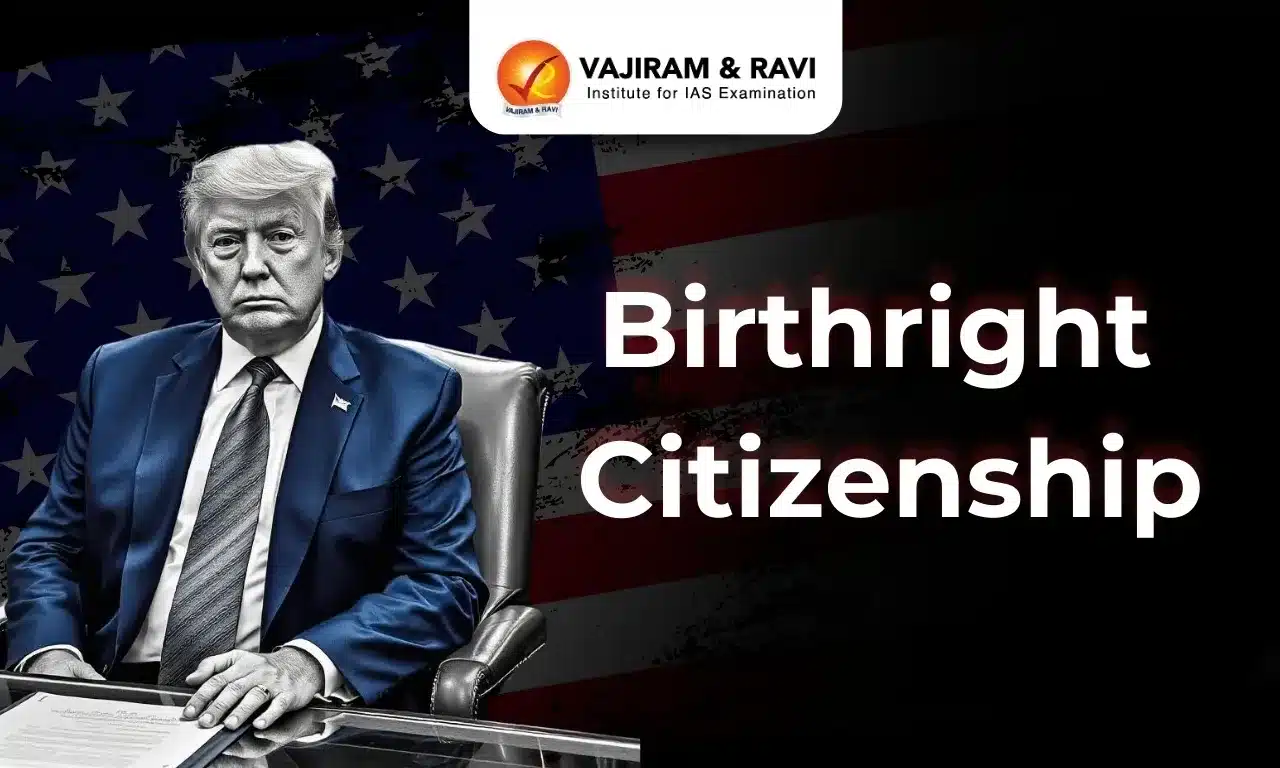What’s in today’s article?
- Birthright Citizenship Latest News
- About Birthright Citizenship in the US
- Birthright Citizenship and the 14th Amendment
- Trump’s Executive Order on Birthright Citizenship
- Categories Excluded from Birthright Citizenship
- Interpretation
- Legal Challenge
- Impact on the Indian Community
- Conclusion
- Birthright Citizenship FAQs
Birthright Citizenship Latest News
- On his first day in office, US President Donald Trump signed several executive orders, including a controversial one aimed at ending birthright citizenship for children of parents without legal status.
- This decision drew immediate backlash, prompting lawsuits from immigrant and civil rights groups, such as the American Civil Liberties Union.
About Birthright Citizenship in the US
- Birthright citizenship automatically grants citizenship at birth.
- In the US, it exists in two forms: jus soli (citizenship based on birthplace) and jus sanguinis (citizenship based on ancestry, for children born abroad to US citizens).
Birthright Citizenship and the 14th Amendment
- The Fourteenth Amendment of the US Constitution, adopted in 1868 after the Civil War, guarantees birthright citizenship.
- It states that “all persons born or naturalized in the United States, and subject to the jurisdiction thereof, are citizens of the United States and of the state wherein they reside.”
- This was originally intended to ensure citizenship for America-born children of formerly enslaved people.
Trump’s Executive Order on Birthright Citizenship
- US President Trump has signed an executive order ending birthright citizenship for children of parents without legal status.
Categories Excluded from Birthright Citizenship
- According to Trump’s executive order, individuals not subject to the jurisdiction of the US Constitution fall into two main categories:
- Unlawful Presence
- When the mother was unlawfully present in the US at the time of birth.
- The father was neither a US citizen nor a lawful permanent resident.
- Lawful but Temporary Presence
- When the mother was lawfully in the US temporarily (e.g., under a visa or the Visa Waiver Program).
- The father was neither a US citizen nor a lawful permanent resident.
Interpretation
- President Trump’s executive order challenges the traditional interpretation of the 14th Amendment.
- It emphasizes that birthright citizenship is not universally applicable.
- It argues that the amendment excludes individuals born in the US who are not “subject to the jurisdiction thereof.”
Legal Challenge
- Requirement for a Constitutional Amendment
- Eliminating birthright citizenship would require a constitutional amendment. This process demands:
- A two-thirds majority vote in both the House of Representatives and the Senate.
- Approval by three-quarters of US states.
- Republican Majority
- Trump’s Republican Party holds a majority in both the House of Representatives and the Senate, which could influence the legislative process.
Impact on the Indian Community
- The executive order seeks to revoke automatic citizenship for children born in the US to non-citizen parents, potentially impacting immigrant communities, including Indian Americans.
- H-1B Visa Holders and Green Card Backlogs
- Indian professionals on H-1B visas and Green Card applicants will be affected as their US-born children may lose automatic citizenship.
- Families already waiting for Green Cards face additional uncertainty about their children’s future in the US.
- Indian Students in the US
- Indian students, who form a significant group of international students in the US, will face difficulties securing citizenship for children born during their study tenure.
- Discouragement from Moving to the US
- Indian professionals, students, and families may opt for immigration-friendly countries like Canada and Australia instead.
- Economic Impact
- The Indian community contributes significantly to the US tech industry, healthcare, and education sectors. Revoking birthright citizenship could reduce these contributions.
Conclusion
Trump’s executive order has created uncertainty for Indian professionals, students, and families in the US. While legal challenges are underway, the potential loss of automatic citizenship could deter Indians from seeking opportunities in the US, shifting their focus to other countries.
The Indian-American community, one of the fastest-growing immigrant groups, will be significantly affected if the policy is implemented.
Birthright Citizenship FAQs
Q1. What is birthright citizenship in the US?
Ans. Birthright citizenship automatically grants US citizenship to anyone born on American soil, regardless of parental immigration status.
Q2. Which groups will be impacted by Trump’s executive order on birthright citizenship?
Ans. H-1B visa holders, Green Card applicants, students, and undocumented immigrants may lose automatic citizenship for their US-born children.
Q3. How does the 14th Amendment protect birthright citizenship?
Ans. The 14th Amendment guarantees citizenship to all individuals born or naturalized in the US and under its jurisdiction.
Q4. Why might Indian professionals avoid the US after this order?
Ans. Uncertainty over citizenship for US-born children may push Indian professionals toward immigration-friendly countries like Canada and Australia..
Q5. What are the legal challenges to Trump’s executive order?
Ans. Immigrant rights groups argue the order violates the 14th Amendment and requires a constitutional amendment for implementation.
Last updated on June, 2025
→ UPSC Notification 2025 was released on 22nd January 2025.
→ UPSC Prelims Result 2025 is out now for the CSE held on 25 May 2025.
→ UPSC Prelims Question Paper 2025 and Unofficial Prelims Answer Key 2025 are available now.
→ UPSC Calendar 2026 is released on 15th May, 2025.
→ The UPSC Vacancy 2025 were released 1129, out of which 979 were for UPSC CSE and remaining 150 are for UPSC IFoS.
→ UPSC Mains 2025 will be conducted on 22nd August 2025.
→ UPSC Prelims 2026 will be conducted on 24th May, 2026 & UPSC Mains 2026 will be conducted on 21st August 2026.
→ The UPSC Selection Process is of 3 stages-Prelims, Mains and Interview.
→ UPSC Result 2024 is released with latest UPSC Marksheet 2024. Check Now!
→ UPSC Toppers List 2024 is released now. Shakti Dubey is UPSC AIR 1 2024 Topper.
→ Also check Best IAS Coaching in Delhi
























